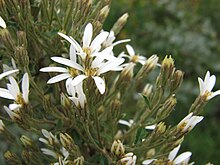Olearia erubescens
| Moth daisy-bush | |
|---|---|

| |
| Olearia erubescens in Kinglake National Park, Victoria | |
| Scientific classification | |
| Kingdom: | Plantae |
| Clade: | Tracheophytes |
| Clade: | Angiosperms |
| Clade: | Eudicots |
| Clade: | Asterids |
| Order: | Asterales |
| Family: | Asteraceae |
| Genus: | Olearia |
| Species: | O. erubescens
|
| Binomial name | |
| Olearia erubescens | |
| Synonyms[1] | |
|
List of synonyms
| |
Olearia erubescens, commonly known as moth daisy-bush or pink-tip daisy-bush,[2] is a species of flowering plant in the family Asteraceae. It is a shrub with stiff, prickly leaves and white "daisy" flowers, growing up to 2 metres high.
Description
[edit]Olearia erubescens is a spreading woody shrub to 0.5–2 m (1.6–6.6 ft) high and 0.5–1 m (1.6–3.3 ft) wide when growing at lower altitudes in grassland and wooded gullies. It has a gnarled smaller growth habit at higher altitudes to 40 cm (16 in) high. The branchlets are densely matted with soft whitish T-shaped hairs. The smooth upper leaf surface is dark green, flat and stiff with a distinctive pale network of veins. The leaves are on a short stalk 11 mm (0.43 in) long, arranged alternately, may be either sparse or crowded and end in a sharp point. The leaves are narrowly oval to oblong about 15–125 mm (0.59–4.9 in) long and 3–20 mm (0.12–0.79 in) wide with small, coarse, irregular teeth or slightly lobed serrations along the margin. The leaf underside is thickly covered with white hairs, occasionally reddish when young. The inflorescence consists of 4-8 white flowers, occasionally a pinkish mauve, about 15–31 mm (0.59–1.2 in) in diameter blooming at the end of branches on a peduncle about 1–4 cm (0.39–1.6 in) long. The flower clusters are borne in leaf axils on previous season shoots. The floret centre is yellow. The cone-shaped bracts are arranged in rows of 3-5 and 4.5–7 mm (0.18–0.28 in) long and covered in dense silky flat hairs. The dry fruit is one seeded, narrowly cylindrical 3–4 mm (0.12–0.16 in) long and ribbed. Flowering occurs from September to January.[3][4][5][6][7]
Taxonomy and naming
[edit]Olearia erubescens was first formally described by Franz Sieber as Aster erubescens but he did not publish the description. In 1826 Curt Sprengel published the description in his book Systema Vegetabilium.[8][9][10] Leopold Dippel in 1889 described Olearia erubescens and published the description in Handbuch der Laubholzkunde.[11]
Augustin de Candolle published the description Eurybia erubescens in Prodromus Systematis Naturalis Regni Vegetabilis in 1836 but makes no reference to Sprengels prior description of 1826.[12] The specific epithet (erubescens) is derived from the Latin meaning "grow red", "redden" or "blush"[13] possibly referring to the new growth that is occasionally a reddish colour.[6]
Distribution and habitat
[edit]Moth daisy bush is a widespread species on the coast and ranges from the Blue Mountains, west to Orange and Drake in the Northern Tablelands of New South Wales. Also found in South Australia, Victoria and Tasmania. Grows in rocky situations, sclerophyll forests, woodland and montane forests.[4][5]
References
[edit]- ^ a b "Olearia erubescens". Australian Plant Census. Retrieved 16 April 2022.
- ^ "Olearia erubescens". Atlas of Living Australia. Retrieved 17 May 2019.
- ^ Wild Plants of Victoria (database). Viridans Biological Databases & Department of Sustainability and Environment. 2009.
- ^ a b "Olearia erubescens". PlantNET - New South Wales Flora Online. Royal Botanic Gardens & Domain Trust, Sydney Australia. Retrieved 2010-10-18.
- ^ a b "Olearia erubescens". VicFlora. Royal Botanic Gardens Foundation Victoria. Retrieved 18 May 2019.
- ^ a b Mullins, Effie. "Olearia erubescens". Growing Native Plants. Australian National Botanic Gardens. Retrieved 18 May 2019.
- ^ Fairley, Alan; Moore, Philip (2010). Native Plants of the Sydney Region. Jacana Books. ISBN 978-1-74175-571-8.
- ^ "Aster erubescens". APNI. Retrieved 20 May 2019.
- ^ Sprengel, Curt. "Systema Vegetabilium". Biodiversity Heritage Library. Retrieved 20 May 2019.
- ^ "Eurybia erubescens". APNI1. Retrieved 20 May 2019.
- ^ "Olearia erubescens". APNI. Retrieved 20 May 2019.
- ^ "Eurybia erubescens". APNI. Retrieved 20 May 2019.
- ^ Brown, Roland Wilbur (1956). The Composition of Scientific Words. Washington, D.C.: Smithsonian Institution Press. p. 651.
